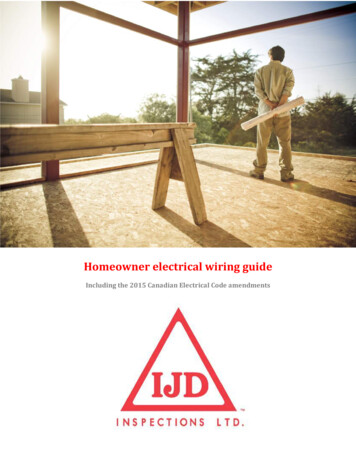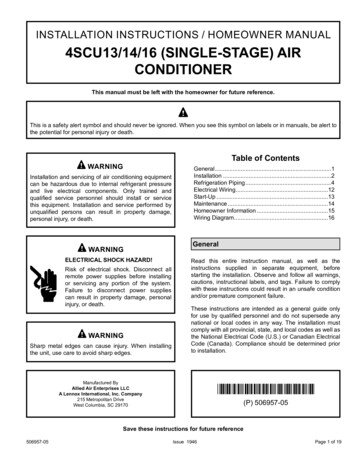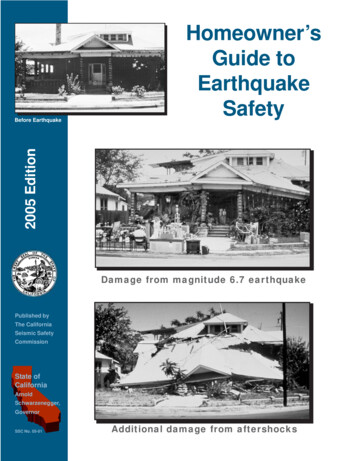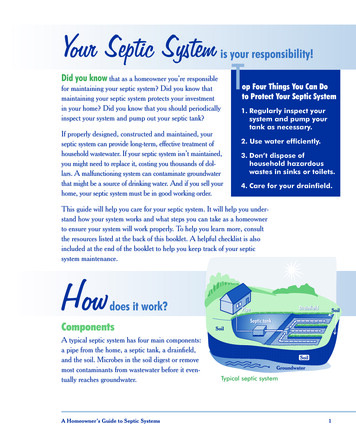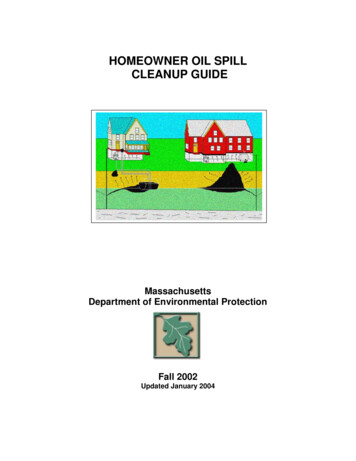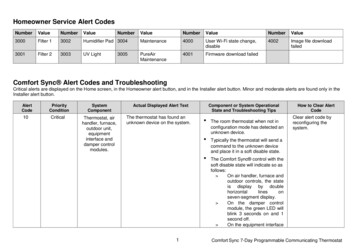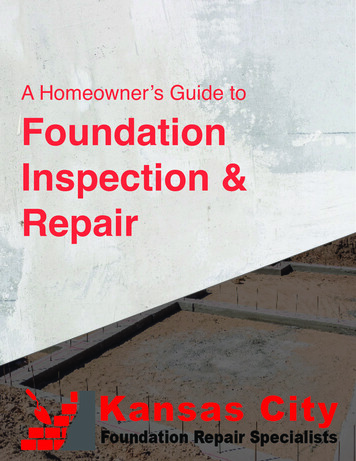
Transcription
A Homeowner’s Guide toFoundationInspection the ts the hotdct1t loa o prote the ear2hgissyal1weertdethe und, it made bGuiExpairssr’prireeatsRrosfneepn&tran th the g ovemeneowon RdimtnoctioiamHweand1r: Actur ontact esistingiFou2uarr3pto3ce’s sctdrArbts&Rdeome in dire ay, ans”ish3ueAnn Conten ectionrrG33uawis’sistes,ofnspts yo dation oisture .al d eowner ilyissu.rrlhouactable ation IprrmtumunupessrucFams eandtrucr “st ir: A Ho me & se that s ome’s fo keeping dampn homeseeFouff2ge,ahasuarurHoemHo
Table of ContentsTypes of Foundations.4Causes of Foundation Damage.8Signs of a Failing Foudation.10What to Expect from Foundation Inspection.14Foundation Repair Methods.15House Leveling.16Advanced Foundation Repair Techniques.18Reasons to Repair a Foundation.21How to Get Started with Foundation Repair.22Foundation Repair Costs.24A Word from Our Foundation Company.27Foundation Inspection & Repair: A Homeowner’s Guide
Ensure a Stable Foundation forYour Home & Family25%The foundation’s job is to be the stable,rigid base that supports your home’sstructure and transfers the weight load tothe underlying soil or rock without excessive settlement or movement. Because ahome’s foundation is in direct contact withthe ground, it also protects the home frommoisture and soil contact. They contribute to insulating against the cold, keepingmoisture away, and resisting movementsmade by the earth below it, which is whyfoundations must rest on firm soil and beprotected from excessive dampness.It’s quite likely that you’ll encounter ahouse with foundation issues during yourhome search.of all U.S. homes will suffer“structural distress”An estimated 25% of all U.S.homes will suffer “structuraldistress” like foundationdamage during their lifetime.Regular inspections and knowing what tolook for can save you not just the headache of dealing with large structural issues,but also quite a bit of money in the future—as long as you plan ahead!Foundation Inspection & Repair: A Homeowner’s Guide3
The Basics - Types of FoundationA foundation can be built with many different materials, but is mostcommonly made with concrete and steel. In order for a foundation to belaid well, a builder needs to make sure to use quality materials, but alsoneeds to lay the proper foundation for the property. Different types offoundations function well for different environments, there are twoprimary types that are most often seen and most commonly used:Slab FoundationSimilar to what it sounds like, slab foundations are a large concrete slabthat is poured on leveled and compacted dirt. A slab is usually pouredall at once and is 4-6” thick. To support the structure, a 24” beam ispoured every 10 feet around the perimeter. Once the slab is cured, abuilding is constructed directly on top of the slab.Pier and Beam FoundationThere are multiple variations of pier and beam homes, but in generalthey are great for small- to medium-sized homes. In simplest terms,brick, stone, and concrete piers are pressed into the ground andleveled, then wooden beams are placed top of the piers, 1-2 feet abovethe ground, in order to create a foundation for the home to be built on.Heavier home structures also feature a concrete footing or grade beam,similar to a slab, that surrounds the perimeter of the home.Foundation Inspection & Repair: A Homeowner’s Guide4
Benefits to Slab FoundationsConcrete slab foundations are often used in warmer climates where grounddoesn’t freeze too often, and are popular because they are less expensive,can be made quickly, and don’t require a crawl space.Common Concerns withSlab FoundationsBecause the slab lays directly on the ground, it is often exposed toweather, and can create water damage to the slab. In colder climates, freeze/thaw cycles often affect slab foundations because water seeps into the soilsurrounding the slab and then expands when it freezes, then contracts whenit thaws—shifting the foundation. With enough movement, the slab can crackor shift into the ground creating stress on any structure that sits on top of it.In addition, the lack of a crawl space with a slab foundation makes access tounderground utilities difficult and expensive.Foundation Inspection & Repair: A Homeowner’s Guide5
Benefits to Pier and BeamFoundationsOne of the obvious benefits of a pier and beam foundationis that it protects again flooding since it is elevated abovethe ground. Also, since the home sits 1-2 feet above theground, it creates a crawl space under the home, allowingeasy access to utilities such as plumbing. The crawl spacecan also allow for easier and less costly repairs tofoundations when repairs are needed.Common Concerns withPier and Beam FoundationsWhile the crawl space provides flood protection, it alsocauses one of the main disadvantages of pier and beamfoundations—since the area is shaded all day, moisture caneasily build up and cause the wooden supports to rot if thearea is poorly ventilated. In areas of flooding or plumbingleaks can increase this risk of damaging moisture under thefoundation. The crawl space can also cause a risk of bug orpest infestation, though this can be prevented with a latticeacross a pier and beam foundation.Flooring in homes that are built on pier and beamfoundations can have less support than a concrete slab, sosqueaking can be common, but there are also ways toprevent creaks by positioning shims between joists andfloorboards.Foundation Inspection & Repair: A Homeowner’s Guide6
Well Laid Home FoundationsThat LastYour foundation is vital for keeping your home standing—butwhat makes a great foundation last?1. No Shortcuts: Builders can’t take any shortcuts with timeand budget. A strong foundation needs the highest qualitymaterials to be strong and effective. A foundation should bemade from poured concrete and steel-reinforced walls.2. Don’t Rush: Curing the concrete is time consuming, butit’s necessary. For a foundation to be at full strength, it needsabout four weeks of slow curing time.3. Quality Soil: Anything and everything that foundation layson can affect the integrity of it. That’s why soil is soimportant. Making sure your foundation is laid on thehighest quality soil that is property compacted will beessential to maintaining a solid foundation.4. Concrete Timing: Concrete needs to be poured in acontinuous action, otherwise it could dry at different timesand the foundation won’t be as strong as it can be.Foundation Inspection & Repair: A Homeowner’s Guide7
Top Causes of Foundation Damage& How to Prevent ThemPoor ConstructionNot every builder is the same, and some contractorsmay work with materials that are below-grade. Onearea to never cut corners when a house is built is withthe foundation, but you never know what you will getwhen purchasing a house that is already built. If you’repurchasing an older home, make sure to bring in aninspector. If you are working with a builder, make surethey are using the highest quality materials for yourhome.SoilSome areas of the country have higher rates offoundation trouble, especially where homes are builton clay soil as they often are in Texas. Clay is moremalleable and can easily expand and contract,especially under pressure. Aside from clay soil, peoplemay find trouble with foundations if the fill dirt belowthe foundation wasn’t compacted properly, which iswhy it’s important to make sure the builders arefollowing code and compacting up to standard.Plumbing LeakA plumbing leak beneath your home is big trouble foryour foundation for a few reasons—they are hard toidentify, access, and repair, and they also cause anincrease in soil moisture under your home. When leaksaren’t detected early, the integrity of your foundationcould be in trouble.Foundation Inspection & Repair: A Homeowner’s Guide8
Top Causes of Foundation Damage& How to Prevent ThemWeatherDrastic weather cycles can have a major impact onfoundations. For example, if your areas fluctuatebetween droughts and floods, the soil moistureexpands and contracts which could make thefoundation shift. Similarly with areas that have regularfreeze/thaw cycles. This can be prevented by usingfoundation watering systems during droughts andin-ground drains during wet seasons.AgingWhile using high-quality materials and properlyinstalling foundation can make it last a long time, it’scommon for foundations to deteriorate after 10-15years from normal wear and tear. Even in the moststrongly built homes, foundation repair will be neededafter a few decades. That’s why it’s necessary to havea foundation inspection regularly, and that you bringin an engineer at the first sign of trouble to performmaintenance before things get really bad.Tree RootsIf you want to plant trees around your house, makesure to consult with a professional landscaper. Sometrees grow very deep and long roots that can affectyour foundation. Roots can either grow under thefoundation, raising it, or they can suck up the waterfrom the soil leaving the soil dry and causing thefoundation to settle unevenly.Foundation Inspection & Repair: A Homeowner’s Guide9
8 Signs Your Home’s FoundationMay Be Failing & What To Look ForThe list of potentially expensive home repairs is long, but for mosthomeowners a home’s foundation is at the top of that list. Knowing how tospot foundation issues early is crucial to prevent expensive damage to yourhome. These are 10 warning signs of foundation issues that you should lookout for:1Cracks and FracturesUsually, small, fine cracks in exterior walls or in the steps aren’tanything to worry about. It’s normal for foundation to sink and developtiny cracks up to 1/16” soon after construction. What should causeworry are large horizontal cracks, gaps in the foundation, or zig-zagpatterned cracks—those may mean there’s something wrong with thefoundation. Even a ¼” gap can mean that your house may beexperiencing more than an acceptable amount of settling. Moderatewall and foundation cracks can mean weakening or damagedfoundation. Floor cracks, wall fissures, cracks in the junctions of wallsor ceilings, and broken chimneys can also mean big trouble to thestructure because these are signs that the foundation has moved ///////////////////////////////2Rotten WoodEspecially in pier and beam foundations, rotten wood can be a signthat humidity in the basement is too high, your crawl space has experienced a flood, or that you have an infestation of termites. It’s better toget someone to take a look sooner rather than later to make sure therearen’t major foundational issues with the home.Foundation Inspection & Repair: A Homeowner’s Guide10
3Foundation UpheavalIf a slab foundation has moved in an upward direction, this means thatyour foundation is experiencing the opposite of settling and this cancause extensive damage. Often this issue impacts hallways,doorways, and outside garage walls. This happens to slab foundationswhen moisture gets under the slab due to rain or plumbing leaks, thenthe soil expands due to a freeze/thaw cycle. This puts pressure on thefoundation, and cracks soon become ////////////////////////////4Uneven or Sagging FloorsMost people don’t even realize that their homes have uneven floorsuntil they spill some water or drop something round and it rolls in onedirection. The big concern for foundations is if the gradient of the flooris more than one or two inches. Sagging or bouncing floors couldmean two things: that the wood is rotting which is a sign of leakingfoundation, or that the foundation has shifted and caused pier andbeam foundations to sag and squeak. Sagging floors or brokenfloorboards could be a hazard inside the house, but unevenfloorboards likely mean foundation issues that need fixing as /////////////////////////5Gaps Around Windows and DoorsWhen windows or door frames have gaps and are pulling away fromthe wall, this is a serious sign that the foundation needs immediatehelp. Similarly, kitchen cabinets or countertops begin to tilt and pullaway from the wall when there are foundation issues. The first sign isseparation of caulking, so if you see this happening, it may be worthgetting someone to come take a look before things get worse.Foundation Inspection & Repair: A Homeowner’s Guide11
6Tile CracksMany things can cause tile cracks, but if you’re seeing tiles cracking inthe kitchen or bathroom along with other signs of foundation damage,you have serious signs of foundation ////////////////////////////7Doors Don’t Open or Close ProperlyVery few homes are at their peak condition after a few years of settling,so it’s likely every home will have it’s issues, but something to look outfor that could mean foundation issues is when doors are out of squareor don’t open and close properly. When foundations are off, interiorand exterior doors may both have issues. Exterior doors can drag atthe threshold or hang at the top unevenly. Interior doors are more likely to stick or drag at the top. Double doors like french doors may notmeet in the middle or they hang funny. Sticking doors could also be anissue of humidity, so make sure to look for this sign in conjunction withother signs of /////////////////////////////8Damp Basement or Crawl SpaceIn addition to rotting floorboards being a sign of foundation trouble,heavy moisture in a crawl space can also be a sign that the foundationis developing trouble. Damp spaces are trouble on many fronts—moldand mildew can make your home smell bad and cause health hazards,moisture attracts termites and other rodents, and of course, moisturecauses wood to rot and fall apart. There are a few ways to preventdampness in the crawl space, depending on the climate of where youlive. If you live somewhere where it rains and floods often, a foundationdrainage system could be beneficial. A polyethylene vapor barrier canalso be installed in a crawl space to prevent water from evaporatingfrom the soil and making the crawl space damp.Foundation Inspection & Repair: A Homeowner’s Guide12
Does it Need Repair oris My House Just Settling?How do you know when your home needs residential foundation repairversus natural settling?Settling is the all-encompassing term used to describe natural changesthat take place in and under a foundation over the years. Over time, anew home will gradually sink into the ground, and of course how muchwill depend on soil composition and climate. There is no exact scienceon how much a foundation will settle over time, but good builders whoknow the area and soil can make a good prediction.Every house sees settlement over theyears—a few inches of settlement isusually nothing to worry about.When you should worry is if your home has ongoing settlement wellbeyond the first few years and that settlement is causing moisture orcompromising the structural integrity of the foundation.Only a structural engineer or foundation repair contractor in your areacan determine if your home needs foundation crack repair,underpinning, and other such work. To know when it’s time to call afoundation repair company near you, note some vital information aboutsettling as well as signs of residential foundation damage. Remember,too, that if you’re unsure about damage to your home’s foundation, calla foundation repair contractor for an inspection just to be sure and soyou can get those repairs done quickly.Foundation Inspection & Repair: A Homeowner’s Guide13
What to Expect From a FoundationInspectionIf you’re seeing any signs of foundation issues, a home foundationinspection by a qualified structural engineer is necessary. Here’swhat you should expect from an inspection.Visual Walk ThroughThe engineer will then inspectinside,outside, and under yourhome, looking for any kind ofdamage, cracks, separations,leaning/listing walls or doors,sticking windows and doors, orany other observable evidence ofsinking or cracking foundation.Under the home, in the crawlspace, the inspector will look forsigns of moisture, including wetspots, rotting wood, or even justmusty smells.Floor Evaluation SurveyYour inspector will then gatherfloor elevation data to determinewhether the foundation is out oflevel. The contractor can evencheck walls, trim, cabinets, anddoorways to see if they are level.Analysis and ReportIf the inspector does find foundation trouble, they will need to determine why it’s happening andcome up with a solution. Theywill verbally explain the findingsof the inspection, and likely offera report along with recommendations on how to fix it.An In-Depth InterviewAn inspection typically beginsby meeting with the inspectorwhere they will ask you questionsabout your concerns and whatyou’ve observed in your home.At this point, you should informthe inspector of the issues you’venoticed along with a timeline ofwhen you began to notice them.Foundation Inspection & Repair: A Homeowner’s Guide14
Repair Methods for FoundationDamageSo you’ve spotted the signs of foundation issues and you know you’rein need of repairs—what options do you have? Your repair needs willgreatly depend on many factors, including soil type, climate, the type offoundation you have, how extensive the damage is, and more. Aconsultation with a foundation repair expert will be able to give you indepth details of your foundation issues and give you a personalizedrecommendation on how to solve it, but here are some of the typicalfoundation repair methods:Pier & Beam Foundation RepairOptionsConcrete Slab FoundationRepair Options1. If water is the primary sourceof damage, a drainage solutionmay be recommended.1. Helical, concrete or steel piers orbeams may need to be installedalong the home’s exterior. Thesebeams help compact the soiland add strength to the foundation.2. If existing piers are up toindustry standards, they may bereleveled.3. If new piers are needed, they willbe installed in critical areas toreinforce and stabilize the home.4. If concrete footing lookscompromised, a new one mayneed to be installed.2. Slabjacking: Foundation jackingmay be needed to injectmaterials like high-density polyurethane foam or grout under thefoundation into the soil to boostit up. The foam expands andhardens to correct cracks.3. The heavier and larger the home,the stronger the foundationrepair must be.Foundation Inspection & Repair: A Homeowner’s Guide15
What is House Leveling?House leveling refers to returning or restoring a houseto a level and even position, original to when the housewas constructed. House leveling, slab jacking, andother foundation repair services allow for structuraldamage repairs while protecting a home from futuredamage.Common signs of needed house leveling include: Stuck cabinets, windows, & interior doors Sloping or warped floors Cracks along interior floors, walls, and ceilings Leaning or cracked chimney stacks Interior and cabinet doors that swing open ordon’t close completely Severely cracked plaster walls or ceilingsWhile interior wall and ceiling cracks and other signs ofneeded house leveling might be the result of water damage and other such causes, it’s vital that homeownersschedule house leveling services as soon as needed.Neglecting this service allows that damage to get worseover time while also increasing the risk of interior waterleaks and resultant mold growth, electrical systems damage, and a collapsed chimney.Foundation Inspection & Repair: A Homeowner’s Guide16
When is House Leveling ///////////////////////////The best way to determine if you need house leveling is to schedule a foundation inspection from a foundation repair contractor. They can note anyunevenness and damage to a home’s foundation and measure the level ofsinking exactly.A foundation repair contractor can also note the risk factors for your home,given the level of damage to a foundation. However, a homeowner mightalso note some signs of needed house leveling, so you don’t put off thiswork and are sure to call a foundation repair person as soon as ///////////////// Visible cracks in the walls are one of the most obvious signs of neededhouse leveling. When a home shifts, settles, or tilts, this puts undue stresson sections of interior walls which then tend to crack or split. Entryway doors and windows stick or refuse to close also typically meanthat your house is sinking or sagging! When a door or window frame tips ortilts, the door or window pane might not go with it so that it then sticksinside the frame. If they all tilt together, the door or window might hangdownward and be difficult to close. Gaps between walls and ceilings are also a sign of needed foundationrepair. As a house shifts and sags, wall studs and other parts of its framework might pull away from roof beams and joists. You might then see cracksor gaps running along the top of the wall where it should meet the ceiling. Sloping floors and other unlevel surfaces in the home often typically meanthat your house needs leveling. If items on shelves suddenly start to slide orlook lopsided, or if you put a ball in the middle of a floor and it starts rollingon its own, you probably need house leveling. Swelling basement walls often indicate a sloping side of a house and theneed for house leveling. Bowing or sagging wood floors in the home might indicate a sunken areathat needs jacking up and leveling.Foundation Inspection & Repair: A Homeowner’s Guide17
Advanced FoundationRepair TechniquesFrom a construction prospective, some landscapes present uniquechallenges. Primarily, the different weather conditions each season bringshas a huge impact on soil moisture content. For example, some summersmay bring rain while others may be bone dry. Rain causes clay soil to expand creating pressure against a home foundation. When this moistureevaporates, the soil contracts, becomes less supportive, and the foundationcan shift. If foundation issues, such as cracks, are present, it is best toconsult with a foundation repair specialist.Advanced foundation repair techniques that not only fill thecracks and level the structure, but also address underlyingcausal factors.Foundation Inspection & Repair: A Homeowner’s Guide18
4 Advanced Techniques forFoundation Repair1Helical PilingsHelical pilings, also referred to as screw piles, areanother technique used for advanced foundation repair. Theyare drilled into the ground much like a metal screw through ablock of wood. The benefit of helical pilings is that installationrequires less effort, and therefore, are sometimes more costeffective. Helical pilings are generally recommended for slabor pier and beam foundations that are not heavy. Dependingon the foundation strength and depth, helical pilings are worthconsidering, but should also be avoided in somecircumstances. Helical pilings can be extremely effective forhouse and foundation /////////////////////////////2MudjackingIn the foundation repair industry, concrete is often referred toas mud. Therefore, mudjacking or slab-jacking is theprocess of raising and repairing a slab foundation by pressureinjecting concrete underneath a foundation. Usually, a lowerstrength concrete is used to facilitate this advancedfoundation repair technique. Some homes with foundationproblems are not always compatible with this strategy, but itcan be useful when conditions are appropriate. For homeswhere mudjacking is not a good option, a variety of otheradvanced foundation repair methods are utilized to effectivelyrepair the foundation.Foundation Inspection & Repair: A Homeowner’s Guide19
3Concrete and Steel PiersConcrete piers are used as cost-effective foundationsupports that are placed under a home. They are especiallyeffective for combating clay soil conditions and can be drilledor poured into the earth around and under a structure.Pressure around 10,000 psi is used to drill the piers around10-15 feet below the foundation. Piers can also be created bypouring concrete directly into manufactured holes around thefoundation. Both poured and drilled piers are often reinforcedwith rebar and it can take 1-2 weeks before the piers have setfully. Steel piers, which can be drilled much further into theground, are used in more advanced foundation repair. Claysoil is notorious for expanding and contracting frequently, andtherefore, it’s sometimes necessary to use a stronger materiallike steel. Like concrete piers, these are drilled into the earth,but can reach incredible depths of 60 or 70 /////////////////////////4Soil InjectionSoil injection, or injection stabilization, chemically alters thesoil using potassium ions. For advanced foundation repair,this technique is sometimes required due to the expansiveness of the clay soil. Penetrating the clay with a potassiumbased chemical solution results in a more stable soil zone.Therefore, any future shifting and heaving of the foundationsis drastically reduced or non-existent. Soil injection is a costeffective solution to digging up and replacing clay soil duringconstruction. Since it permanently reduces soil swelling, it isan extremely effective advanced foundation repair strategywhen other means are ineffective.Foundation Inspection & Repair: A Homeowner’s Guide20
5 Reasons To Repair Your Home’sFoundationBefore you decide that you can put off foundation repair for another year,you might note these reasons why concrete crack repairs are so vital. Thiswill ensure you call a foundation repair contractor and have those crackspatched and filled or have your home underpinned as needed.1. Cracks in a structure’s foundation allow water to seep in. Don’t underestimate theextent of damage caused by water leaks in a foundation, as a structure’s woodframework absorbs this moisture and then softens and cracks itself. Excessivedampness and water in a home also increase the risk of mold growth and attractsinsects and rodents looking for a water source.2. Foundation damage affects your home’s overall value. You might not think much ofthe value of your property if you’re not considering putting your home on the realestate market, but note that a house’s value is considered when you apply for ahome equity loan or any other such secured loan.3. Small cracks in a foundation and other such minor damage only gets worse overtime. The weight of a structure, pressure from surrounding soil, and other suchfactors will cause small cracks to spread and allow larger sections of a structure’sfoundation to chip and crack. Repairing a foundation now will avoid that damageand keep foundation repair costs contained.4. Foundation repair helps avoid damage to the structure’s interior. As a badfoundation continues to crack, chip, or otherwise suffer damage, a home orcommercial building will shift and settle with it, allowing cracks to form alonginterior walls, ceilings, and floors. Foundation repair helps avoid this damage andthe cost of patching or replacing interior building materials.5. Repairing foundation cracks and other damage helps contain your utility costs, asheating and cooling is often lost through cracks in a foundation as well as resultantgaps around windowsills and door frames. When a structure’s foundation is strongand stable, you avoid these resultant gaps and keep your structure’s interior dryand comfortable year-round.Foundation Inspection & Repair: A Homeowner’s Guide21
Getting Started withFoundation RepairFoundation isn’t a do-it-yourself project, but it also canbe expensive, so it’s important that you get the most outof what you’re paying for. Here are some tips for hiring areputable company for your foundation repair.Ask QuestionsEducate yourself on the options and make sure that it’sthe right choice for your needs and your budget.Think Quality Control and SafetyLook for contractors that are highly knowledgeable intheir field and will correct foundation issues safety andsecurely.Find a Reputable ContractorLook for honest, trustworthy, and reliable companies thathave experience and train their contractors to providequality work.Look for Good ReviewsEvery company will say they’re great, but if you wanthonest reviews and feedback, ask family and friends forrecommendations, or look to sites like the Better BusinessBureau to get good feedback.Warranties and GuaranteesPay attention to the terms: a warranty is as good as thecompany that backs it. Make sure the company has aplan to provide follow-up services if needed.Foundation Inspection & Repair: A Homeowner’s Guide22
Foundation Repair OptionsYour foundation repair options will depend on the type of foundationholding up your home or commercial structure, the type and extent ofdamage to the foundation, and if you want to invest in strengtheningyour foundation against future damage while repairs are ///////////////////////// Cracks wider than 1/8” need repairs. If your foundation hascracks larger than 1/8”, it’s also recommended to consult with astructural engineer, to note if your home or business is sinking,shifting, or otherwise in danger of future foundation damage.Silicone or other patching materials are injected into the cracksand allowed to dry.
Foundation Inspection & Repair: A Homeowner's Guide 7 1. No Shortcuts: Builders can't take any shortcuts with time and budget. A strong foundation needs the highest quality materials to be strong and effective.
